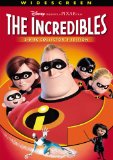I have a three-year-old, and as three-year-olds are wont to do, he likes to watch the same movie over and over and over for about two weeks straight. So when I wanted to show the three- and five-act structures in action, I knew I had to use his latest obsession: The Incredibles.
 I’m comparing the different structures’ divisions of the “text” here, so the synopsis will be largely the same, but the placement of the acts will vary among the three act, Freytag’s five act and my five act structures.
I’m comparing the different structures’ divisions of the “text” here, so the synopsis will be largely the same, but the placement of the acts will vary among the three act, Freytag’s five act and my five act structures.
Three act structure
(Paragraphing is mostly for readability.)
Act I—Setup—the characters’ world (still with conflict): Super heroes were celebrated icons. Bob (Mr. Incredible) and Helen (ElastiGirl), super heroes, get married. Super heroes fall out of favor and are hidden by the government.
Fastforward 15 years, and Bob and Helen are trying to look like a typical suburban family. Bob is dissatisfied with his life. The kids aren’t happy with hiding (or having) their super powers. Bob loses his job.
First turning point: Mr. Incredible is offered a secret super hero assignment and decides to take it. He also decides not to tell his wife that he has been fired or offered this high-paying assignment.
Act II—Confrontation—lots of rising conflicts: Mr. Incredible completes the assignment on a remote island. When he returns for a second assignment, he finds out there’s a villain, learns of the villain’s secret plans and is captured. His wife and kids come to save them. They learn to use their powers together, but are captured. They watch as the villain’s dastardly plan plays out in their home town, then the villain leaves to play his role there as well.
Second turning point/climax: Working together, the family escapes and pursues the villain and his evil robot. They defeat the robot.
Act III—Resolution: They return home and save the baby from the villain. They’re now a family of super heroes, and are happy and united against the forces of evil.
Freytag’s Five Act Structure
Act I—Setup: Super heroes were celebrated icons. Bob (Mr. Incredible) and Helen (ElastiGirl), super heroes, get married. Super heroes fall out of favor and are hidden by the government.
Fastforward 15 years, and Bob and Helen are trying to look like a typical suburban family. Bob is dissatisfied with his life. The kids aren’t happy with hiding their super powers. Bob loses his job.
Act II—Rising Action: Mr. Incredible is offered a secret super hero assignment and decides to take it. He also decides not to tell his wife that he has been fired or offered this high-paying assignment. (This is really the divider between act I and II still.)
Mr. Incredible completes the assignment on a remote island. When he returns for a second assignment, he finds out there’s a villain and learns of the villain’s secret plans.
Act III—Turning Point/Midpoint: Suspecting her husband is doing something not-so-good, Helen activates the homing beacon in his super suit. She knows where he is now—but the homing beacon alerts the villain of Mr. Incredible’s presence and he’s captured again.
Act IV—Falling Action: (booooring name). Helen and the kids come to his rescue. They learn to work together as a team, but are ultimately captured. The villain attacks their hometown with his evil robot.
Act V—Resolution: They escape and defeat the evil robot. They return home and rescue the baby from the villain. They are happy and united as a family against the forces of evil.
My Five Act Structure
 Act I—Setup: Super heroes were celebrated icons. Bob (Mr. Incredible) and Helen (ElastiGirl), super heroes, get married. Super heroes fall out of favor and are hidden by the government.
Act I—Setup: Super heroes were celebrated icons. Bob (Mr. Incredible) and Helen (ElastiGirl), super heroes, get married. Super heroes fall out of favor and are hidden by the government.
Fastforward 15 years, and Bob and Helen are trying to look like a typical suburban family. Bob is dissatisfied with his life. The kids aren’t happy with hiding their super powers. Bob loses his job.
Act II—Rising Action: Mr. Incredible is offered a secret super hero assignment and decides to take it. He also decides not to tell his wife that he has been fired or offered this high-paying assignment. (This is really the divider between act I and II still.)
Mr. Incredible completes the assignment on a remote island. When he returns for a second assignment, he finds out there’s a villain and learns of the villain’s secret plans.
Suspecting her husband is doing something not-so-good, Helen activates the homing beacon in his super suit. She knows where he is now—but the homing beacon alerts the villain of Mr. Incredible’s presence and he’s captured again.
Helen and the kids come to his rescue. They learn to work together as a team, but are ultimately captured.
Act III—Climax: The villain attacks their hometown with his evil robot. They escape and defeat the evil robot. They return home and rescue the baby from the villain.
Act IV—Falling action: A few months later, they attend a track meet for their son with superhuman speed (who was acting out in the setup b/c he had no other outlet), whom they finally let compete in sports. Their shy daughter is now confident enough to ask her long-time crush on a date—and he’s the one who gets flustered.
Act V—Resolution: As they leave a track meet, a new villain appears. They don their masks and grin, ready to take on the new challenge.
Quiz time: read Acts IV and V under My Five Act Structure. What’s the story question? Did they ask and answer the same question?


I think they did answer the question. The question: ‘Will they become acknowledged Super Heroes and not have to hide their powers?’
The answer is: They’re happy Super Heroes again and can publicly take on new challenges.
I agree! Good job—it was a trick question.
Good job—it was a trick question.
Well, I’ve learned a lot from you this week, Jordan. In fact, I had to go and edit the last two chapters of my latest book, as well as my blog post. Thanks for that. No, I’m not being sarcastic, I really appreciate it.
Cheers,
Trish.
You’re welcome—but we’re just getting started .
.
Good, I love to learn and can’t wait for the next installment.
Excellent post, Jordan. I’ve done the 3 act breakdown for Collateral, LA Confidential, and Get Carter, but yours sounds like a whole lot more fun. And you were being a good mummy, to boot. Freytag’s 5 acts sounds a lot like the old W formula we used to use in the day. Sure helps when I’m stuck on a new WIP and can’t break away from TV long enough to forge ahead. Right now is a tough time because of all the new series. What if I miss something really really good??? lol
@Joylene—Oh, man. Don’t get me started on TV. I always end up writing in front ot he TV, and always very slowly. I keep expecting it to help, give me some good ideas, but it never happens.
I recently watched the film, The Majestic with Jim Carey. He actually played a serious part for a change. I loved it. It gave me inspiration. I’ll check the 3 act breakdown too.
Oooh, it’s been a long time, but my guess would be that the first turning point is the head trauma and waking up in this town, and the second is when he realizes he’s not Luke? What would you say, with the movie fresh in your mind?
Yes, I agree there, Jordan. I just love the ending, and the drama in the court room when he stands up for himself. Then finally going back to the Majestic. It’s a movie I could watch a few times before getting bored.
For the record, I think it’s called the falling action because that is the point at which things events begin to seem inevitable. The characters are “falling” toward the resolution, and no matter what happens, they’re going to either land on their feet or fall on their face, but either way, things aren’t ever going to be the same. (For example, in this movie, the turning point is when Mr. Incredible gets captured and the family dons their superhero gear to go save him. After that, they can’t go back to their life in hiding, or even if they do, it will never be the same for them again.) At least, that’s the impression I always had… Not at all the same as a denouement.
I like that explanation. “My” five act structure is based on how I first learned dramatic and literary structure, which placed the Falling Action after the climax and before the denouement. It doesn’t take a lot of explaining in that context. (A full explanation of how I learned it is here: http://jordanmccollum.com/2009/09/act-story-structure/ )